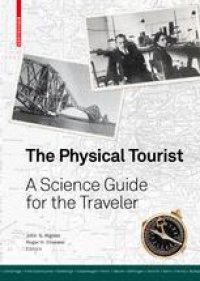
Ebook: The Physical Tourist: A Science Guide for the Traveler
- Tags: History of Physics
- Year: 2009
- Publisher: Birkhäuser Basel
- Edition: 1
- Language: English
- pdf
Typical travel guides have sections on architecture, art, literature, music and cinema. Rarely are any science-related sites identified. For example, a current travel guide for Germany contains one tidbit on science: Einstein is identified as the most famous citizen of Ulm. By contrast, this travel guide walks a tourist through Berlin and identifies where Max Planck started the quantum revolution, where Einstein lived and gave his early talks on general relativity, and where, across the street, Einstein’s books were burned by the Nazis. Or, if you are walking in Paris, this guide tells you where radioactivity was discovered and where radium was discovered. Scientific discoveries of the past, like art of the past, has shaped life in the 21st century. From this travel guide, a tourist will learn what other guides leave out.
Typical travel guides have sections on architecture, art, literature, music and cinema. Rarely are any science-related sites identified. For example, a current travel guide for Germany contains one tidbit on science: Einstein is identified as the most famous citizen of Ulm. By contrast, this travel guide walks a tourist through Berlin and identifies where Max Planck started the quantum revolution, where Einstein lived and gave his early talks on general relativity, and where, across the street, Einstein’s books were burned by the Nazis. Or, if you are walking in Paris, this guide tells you where radioactivity was discovered and where radium was discovered. Scientific discoveries of the past, like art of the past, has shaped life in the 21st century. From this travel guide, a tourist will learn what other guides leave out.
Typical travel guides have sections on architecture, art, literature, music and cinema. Rarely are any science-related sites identified. For example, a current travel guide for Germany contains one tidbit on science: Einstein is identified as the most famous citizen of Ulm. By contrast, this travel guide walks a tourist through Berlin and identifies where Max Planck started the quantum revolution, where Einstein lived and gave his early talks on general relativity, and where, across the street, Einstein’s books were burned by the Nazis. Or, if you are walking in Paris, this guide tells you where radioactivity was discovered and where radium was discovered. Scientific discoveries of the past, like art of the past, has shaped life in the 21st century. From this travel guide, a tourist will learn what other guides leave out.
Content:
Front Matter....Pages i-viii
The Whipple Museum and Cavendish Laboratory, Cambridge....Pages 1-5
Scientific Travels in the Irish Countryside....Pages 7-20
Physics in Edinburgh: From Napier’s Bones to Higgs’s Boson....Pages 21-54
Historical Sites of Physical Science in Copenhagen....Pages 55-72
A Parisian Walk along the Landmarks of the Discovery of Radioactivity....Pages 73-80
Physics in Berlin I: The Historical City Center....Pages 81-90
II: Through the Western Part of the City: Charlottenburg....Pages 91-110
Some Historical Points of Interest in G?ttingen....Pages 111-119
Peripatetic Highlights in Bern....Pages 121-143
Vienna: A Random Walk in Science....Pages 145-173
Budapest: A Random Walk in Science and Culture....Pages 175-213
Physics and New York City....Pages 215-249
Typical travel guides have sections on architecture, art, literature, music and cinema. Rarely are any science-related sites identified. For example, a current travel guide for Germany contains one tidbit on science: Einstein is identified as the most famous citizen of Ulm. By contrast, this travel guide walks a tourist through Berlin and identifies where Max Planck started the quantum revolution, where Einstein lived and gave his early talks on general relativity, and where, across the street, Einstein’s books were burned by the Nazis. Or, if you are walking in Paris, this guide tells you where radioactivity was discovered and where radium was discovered. Scientific discoveries of the past, like art of the past, has shaped life in the 21st century. From this travel guide, a tourist will learn what other guides leave out.
Content:
Front Matter....Pages i-viii
The Whipple Museum and Cavendish Laboratory, Cambridge....Pages 1-5
Scientific Travels in the Irish Countryside....Pages 7-20
Physics in Edinburgh: From Napier’s Bones to Higgs’s Boson....Pages 21-54
Historical Sites of Physical Science in Copenhagen....Pages 55-72
A Parisian Walk along the Landmarks of the Discovery of Radioactivity....Pages 73-80
Physics in Berlin I: The Historical City Center....Pages 81-90
II: Through the Western Part of the City: Charlottenburg....Pages 91-110
Some Historical Points of Interest in G?ttingen....Pages 111-119
Peripatetic Highlights in Bern....Pages 121-143
Vienna: A Random Walk in Science....Pages 145-173
Budapest: A Random Walk in Science and Culture....Pages 175-213
Physics and New York City....Pages 215-249
....